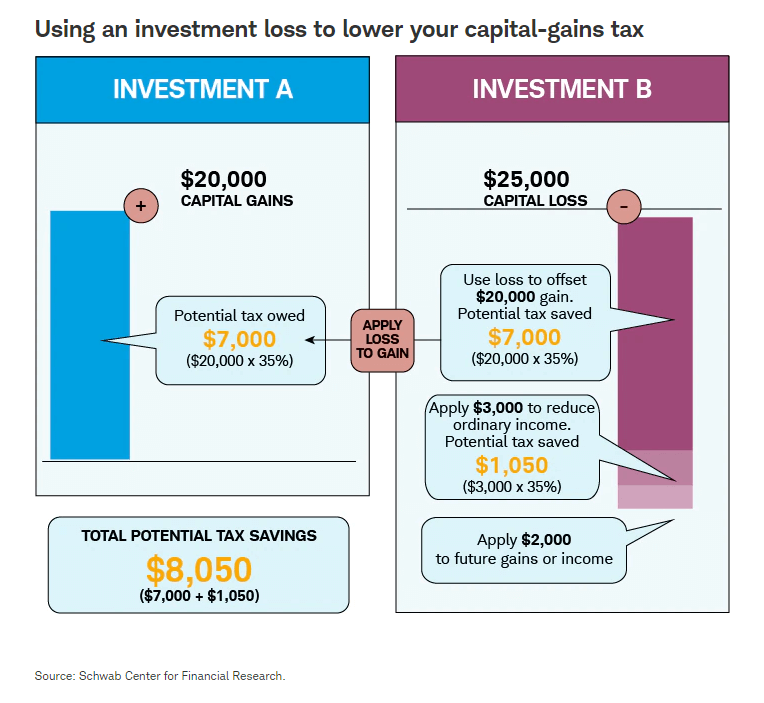- October 28, 2022
- Mike Minter

Tax-Loss Harvesting: A Silver Lining
In a year like 2022, where there’s been virtually nothing positive to talk about from an investing perspective, we try to make the best of a bad situation. One silver lining in a down market is the potential for tax-loss harvesting.
Now, that’s not to say we want our clients to be in this spot, and fortunately this scenario does not play out often. But, as professional investment managers we look for every opportunity to improve the long-term outlook of our investment portfolios.
For our clients with taxable accounts, you may have observed various buys and sells over the last several months – selling securities with “losses” and immediately buying into a replacement security. This is due to tax-loss harvesting. And we’ve done a significant amount of it this year. I’ll give a quick kudos to our two Associate Portfolio Managers, Grant Ball and Tim Garcia-Prats, for doing the heavy lifting on this.
Tax-loss harvesting gives you the opportunity to offset gains you may have made in the previously booming market, along with ordinary income. Any losses not used in that year can be applied to future years.
It’s a strategy to use with taxable accounts – a tax-deferred retirement account (IRA or 401(k)) simply won’t give you an opportunity to lower your tax bill. This tax-loss selling, though, does require a thorough knowledge of tax laws and some research into the right ways to sell and buy so you don’t violate rules that will reduce the amount you can claim as a loss.
We monitor portfolios continuously for these opportunities because often times they are short-lived. For example, back in 2020 during the pandemic-driven market downturn, we acted on tax-loss harvesting quickly. Subsequently, the market experienced a historic rebound and by year-end, those tax-loss opportunities evaporated.
Important Consideration
Some investment managers and individual investors only look for tax-loss harvesting opportunities annually, usually near year-end. Although better than nothing, we believe this is a mistake. We monitor portfolios continuously for these opportunities because often times they are short-lived. For example, back in 2020 during the pandemic-driven market downturn, we acted on tax-loss harvesting quickly. Subsequently, the market experienced a historic rebound and by year-end, those tax-loss opportunities evaporated.
Let’s look further into the basics of tax-loss harvesting and how we utilize this portfolio management tool.
What is Tax-Loss Harvesting?
Simply put, tax-loss harvesting lets you use an investment loss to offset some of your tax burden. For those investors who have realized capital gains from selling during the high points of the market, a tax-loss sale can help offset those gains. Any unused losses can be carried into future years with no time limit.
This strategy can reduce or eliminate investment portfolio tax bills in the current year, and any loss carryforwards will help us in our rebalancing efforts going forward.
The ideal securities to consider selling for tax-loss harvesting are those that are currently trading well below your cost basis, or the total you spent for shares, dividends that were reinvested, and any distributions for capital gains.
Effective tax-loss harvesting generally works like this:
- You sell an investment with a taxable loss.
- You reinvest the money from the sale into a different security that meets your investment needs and asset-allocation strategy.
- Then, you use that loss to reduce/eliminate your taxable capital gains and potentially offset up to $3,000 of your ordinary income.
*Pay special attention to step #2 above, because this is critical. We never just sell a security at a loss without immediately reinvesting those proceeds into a similar replacement fund. We want to maintain exposure to that asset class and stay fully diversified to benefit from any rebound in the market. We do not want to compromise the overall portfolio allocation at any time.
Offsetting Capital Gains with Losses
A quick rundown on capital gains: Whenever you sell an investment for more than you paid, you incur capital gains for that tax year (unlike losses, gains can’t be spread out over multiple tax years). Over one year and a day, those are long-term capital gains; under that time, it’s considered a short-term capital gain. These gains are taxed slightly differently depending on your income and whether you file as a single taxpayer, head of household or married.
You can use capital losses to completely eliminate your capital gains. In addition, if your losses are larger than the gains, you can use the remaining losses to offset up to $3,000 of your ordinary taxable income. Any amount over $3,000 can be carried forward to future tax years to offset income down the road.
So, if you haven’t yet realized gains this year, you can still benefit in the future from tax-loss harvesting. Selling at the right time for a calculated loss and swapping securities is a smart way to reduce the tax burden. Your losses can carry forward at $3,000 a year or until you have a significant capital gain.
An Example of Tax-Loss Harvesting
Let’s suppose that you had purchased $10,000 of a popular S&P 500 ETF in mid-February of 2020, when it was at a high of 337.60. At the close of the day on April 1, 2020, the fund was valued at 246.15. If you sold on that day, you’d be unloading 29.6 shares that are now worth $7,291. You have three choices:
1. Hold the fund, hoping it comes back.
2. Sell it, take your loss and deduct that $2,708 from your taxable income this year.
3. Sell the security, take a deduction and/or apply the loss to any capital gains
and then invest in a different security to maintain portfolio balance.
If you want to continue the same market exposure with the least overall financial loss, option 3 – a tax-loss harvest – may be the best choice.
Once you’ve identified the stock or fund you wish to sell, it’s time to find the right security to replace it. Buying a similar security ideally allows you to keep your position in the market, but you can’t snap up the same or nearly identical stock or fund within 30 days before or after the sale. An IRS regulation known as the wash-sale rule prevents you from then taking the tax-loss you’re trying to get. You may, however, move from a mutual fund or ETF to a replacement fund that tracks even slightly different indexes (or is actively managed) as they are not considered “substantially identical” under these tax rules.
One challenge of buying a new security is, well, finding that security. You want something that will perform well despite the rocky road we’re on. It needs to meet our criteria for market sector, region, internal expense, manager, and risk.
Below is an infographic that illustrates the basic mechanics of tax-loss harvesting.

What Does This Mean for Investors?
As the old saying goes, nothing is guaranteed in life except for death and taxes, so it’s safe to say that tax planning is going to be a focus for investors for generations. That’s why we take steps to address these obligations, leveraging techniques such as tax-loss harvesting to minimize taxes while also maximizing after-tax returns.
Thank you for your continued trust and confidence in this difficult year.




